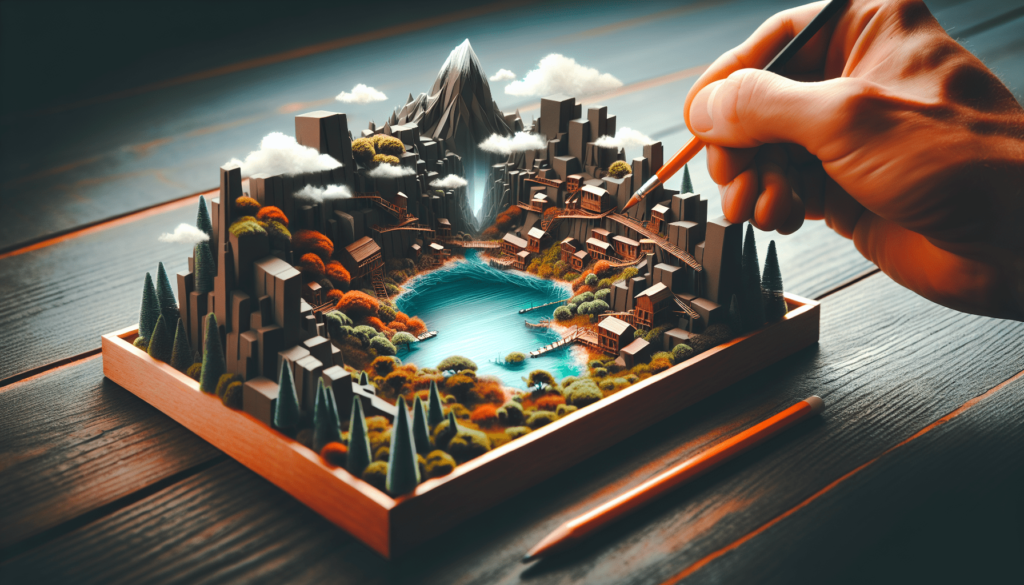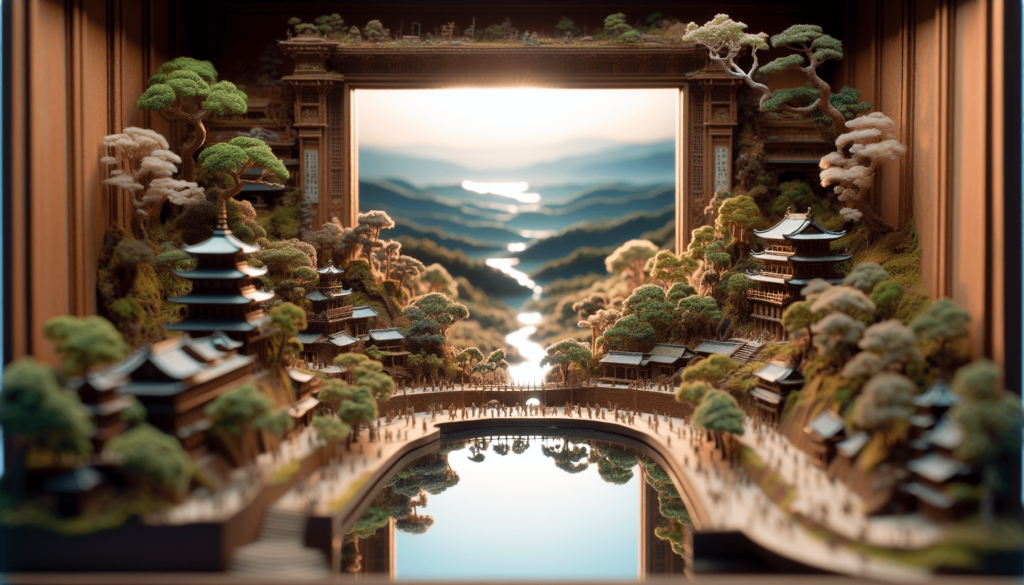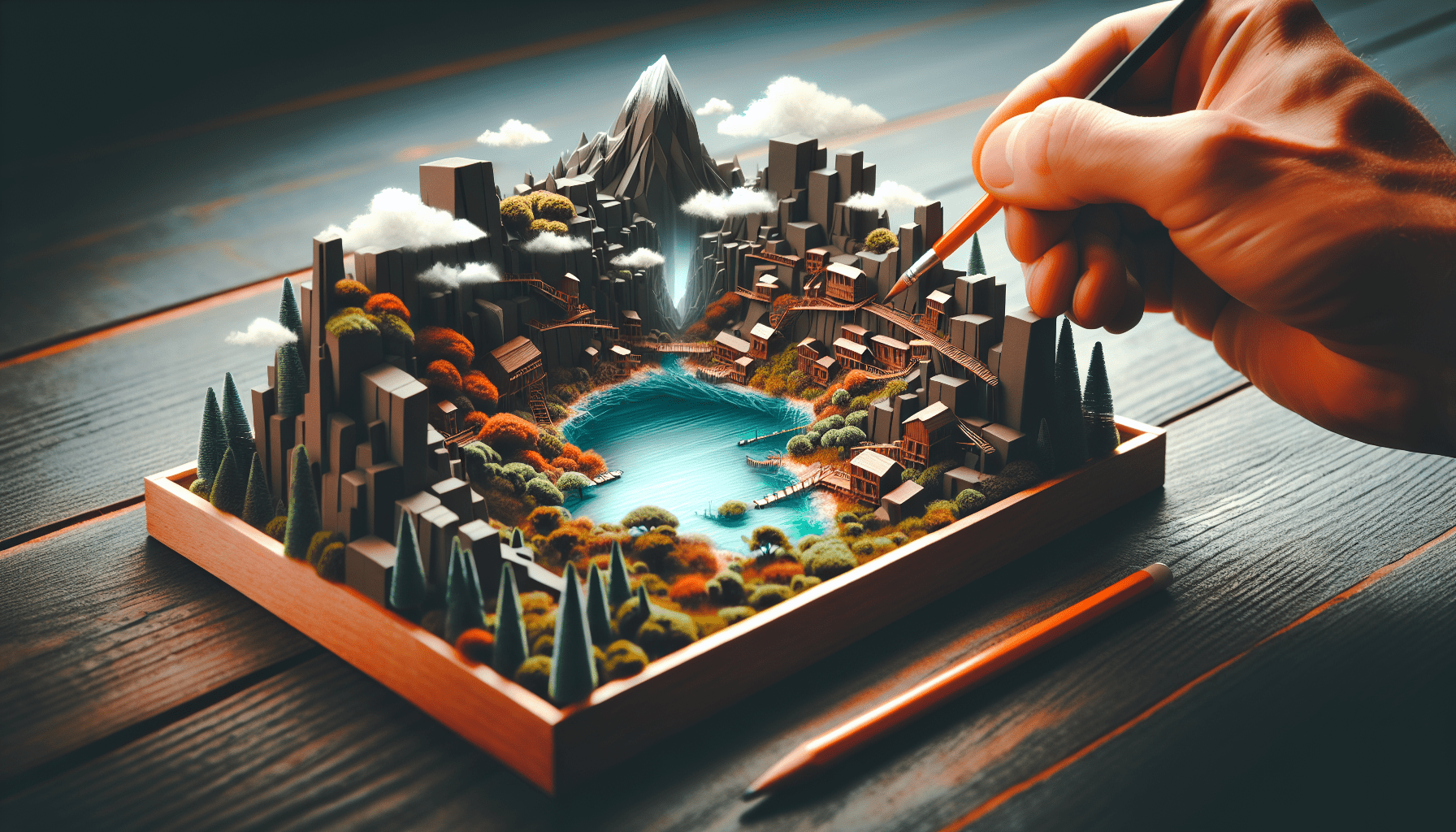In the world of miniature art, the ability to create depth and dimension is paramount. Whether you’re painting a small landscape or sculpting a tiny figurine, bringing a sense of depth to your work can enhance its overall impact. This article explores various techniques that artists can employ to achieve this effect, such as the use of perspective, layering, and shading. By incorporating these techniques into your own miniature creations, you’ll be able to create a captivating sense of depth that draws viewers into your art.
1. Use of Perspective
Understanding perspective in miniature art
When it comes to creating depth in miniature art, understanding perspective is crucial. Perspective is the way objects appear smaller as they recede in the distance, giving a sense of depth and spatial relationships. In miniature art, this technique can be used to create the illusion of a three-dimensional space, even on a small scale.
Using one-point perspective
One-point perspective is a technique that involves creating depth by emphasizing a single vanishing point in the artwork. This technique is commonly used to depict roads, corridors, or any scene with a strong linear perspective. By drawing converging lines that meet at a single point on the horizon, you can give the impression of depth and distance.
Using two-point perspective
In contrast to one-point perspective, two-point perspective involves creating depth using two vanishing points on the horizon. This technique is commonly used in architectural drawings, as it allows for more complex and dynamic compositions. By drawing lines that converge towards two different points, you can create a sense of depth and volume in your miniature art.
Creating depth with overlapping objects
Another effective way to create depth in miniature art is by incorporating overlapping objects. By placing objects in front of one another, you create a sense of space and depth. This technique is particularly useful when working with multiple layers or when creating scenes with various elements. By carefully arranging the objects and ensuring that they overlap in a natural and visually appealing way, you can bring depth and realism to your miniature artworks.
2. Utilizing Shadows
Understanding the effects of light and shadows
Light and shadows play a crucial role in creating depth and dimension in any artwork, and miniature art is no exception. By understanding the effects of light and shadows, you can strategically use these elements to enhance the sense of depth in your miniature creations. Shadows can add depth, volume, and a sense of realism to your artwork.
Using chiaroscuro technique
The chiaroscuro technique involves using strong contrasts between light and dark areas to create depth and dramatic effect in your miniature art. By carefully observing the interplay of light and shadows in real-life objects, you can recreate this contrast in your art. This technique can be especially powerful in creating a sense of depth when applied to three-dimensional objects, such as figurines or architectural models.
Creating depth with cast shadows
Cast shadows can be a powerful tool in creating depth and three-dimensionality in miniature art. By accurately depicting cast shadows in your artwork, you can give the impression that objects are grounded and have a physical presence. Pay attention to the direction and intensity of light sources to ensure that the cast shadows align with the overall composition, creating a convincing sense of depth.
Using ambient light to create depth
Ambient light refers to the soft, diffused light that surrounds objects and fills the environment. By effectively using ambient light in your artwork, you can create a sense of depth and atmosphere. For example, by subtly shading objects to indicate the direction and intensity of ambient light, you can enhance the realism and depth of your miniature art.

3. Layering Techniques
Understanding the concept of layering in miniature art
Layering is a fundamental technique in creating depth in miniature art. By strategically layering objects, you can establish a sense of distance and depth within your artwork. The concept of layering involves arranging objects in a way that visually separates them and creates the illusion of space between them.
Creating depth by layering objects
To create depth through layering, consider the placement of objects within your composition. Objects placed closer to the foreground should appear larger and more detailed, while those in the background should be smaller and less detailed. By gradually decreasing the size and level of detail as objects recede into the distance, you can create a convincing sense of depth.
Using transparent materials for depth
Using transparent or translucent materials can be a creative way to add depth and dimension to your miniature art. Transparent objects can provide a sense of visual layers, allowing the viewer’s eye to perceive depth as they look through the material. Experiment with using glass, plastic, or resin to create transparent elements within your artwork and enhance the overall sense of depth.
Adding texture to create depth
Texture can be a powerful tool in creating the illusion of depth in miniature art. By adding texture to surfaces, you can create visual interest and depth within your artwork. Consider using techniques such as dry brushing or stippling to create texture on objects or surfaces, enhancing the overall sense of depth and three-dimensionality.
4. Scale and Proportion
Understanding the importance of scale and proportion in creating depth
Scale and proportion are essential elements in creating depth and realism in miniature art. By accurately representing the size and relationships between objects, you can create a convincing sense of depth and perspective. Paying attention to scale and proportion ensures that objects in the foreground appear larger, while those in the background appear smaller, creating the illusion of depth and distance.
Using scale to create an illusion of depth
Using scale strategically can enhance the sense of depth in your miniature art. Objects in the foreground should be larger and more detailed, while objects in the distance should be smaller and less detailed. By accurately representing the scale of objects in relation to one another, you can create the optical illusion of depth, making your miniature art appear more realistic and three-dimensional.
Utilizing proportion to give a sense of distance
Proportion refers to the size relationships between different elements within an artwork. By accurately depicting proportion, you can create a sense of distance and depth. Consider using diminishing proportions, where objects appear smaller as they recede into the background. This technique can help establish a convincing sense of depth and perspective in your miniature art.
5. Atmospheric Perspective
Understanding the concept of atmospheric perspective
Atmospheric perspective is a technique used in art to depict a sense of distance and depth by adjusting colors, values, and the overall appearance of objects as they recede into the background. It mimics the natural haze and atmospheric conditions that occur in the real world, where objects become less distinct and saturated as they move further away.
Creating depth by adjusting colors and values
One way to create depth using atmospheric perspective is by adjusting the colors and values of objects as they recede into the background. Objects in the foreground can be depicted with vibrant and saturated colors, while those in the background should appear more muted and desaturated. By gradually reducing the saturation and value of colors, you can create a convincing sense of depth and distance.
Using softer edges for distant objects
In addition to adjusting colors and values, using softer edges for distant objects can also enhance the sense of depth in your miniature art. Distant objects tend to have less defined edges and appear slightly blurred due to atmospheric conditions. By utilizing softer and more diffused edges for objects in the background, you can create a realistic sense of depth and distance.
Depicting aerial perspective to create depth
Aerial perspective refers to the changes in hue, value, and saturation that occur as a result of the interaction between light and particles in the atmosphere. By depicting these changes in your miniature art, you can create a sense of depth and distance. Lighter and bluer hues can be used for objects in the background, simulating the effect of light scattering and atmospheric conditions. This technique can enhance the overall sense of depth and realism in your artwork.
6. Depth through Foreground, Middle Ground, and Background
Understanding the arrangement of objects in miniature art
The arrangement of objects in miniature art is crucial in creating a sense of depth and visual interest. By considering the foreground, middle ground, and background, you can establish a hierarchy that guides the viewer’s eye and creates a convincing sense of depth.
Using the foreground to create a sense of depth
The foreground is the area of your composition that appears closest to the viewer. By carefully arranging objects in the foreground, you can create a sense of depth and immediacy. Objects placed in the foreground should be more detailed, vibrant, and larger in scale compared to those in the middle ground and background. This contrast in size and detail helps create a visual sense of depth.
Establishing a middle ground for perspective
The middle ground serves as a transition between the foreground and background, adding depth and balance to your miniature art. Objects in the middle ground should be smaller and less detailed than those in the foreground but larger and more distinct than those in the background. Pay attention to the arrangement and spacing of objects in the middle ground to create a convincing sense of perspective and depth.
Creating depth with a detailed background
The background of your miniature art plays a crucial role in creating depth and a sense of space. While the level of detail may be reduced compared to the foreground, it is important to add enough visual interest to prevent the background from appearing flat. Consider adding elements such as distant landscapes, buildings, or skies to create depth and enhance the overall visual impact of your artwork.

7. Incorporating Depth in Miniature Landscapes
Understanding the elements of a landscape in miniature art
Creating depth in miniature landscapes requires a careful understanding and incorporation of various elements. These elements include vegetation, mountains and hills, water features, as well as lighting and atmospheric conditions. By effectively utilizing these elements, you can create realistic and visually captivating miniature landscapes.
Using layers of vegetation for depth
Vegetation, such as trees, bushes, and plants, can be a powerful tool in creating depth in miniature landscapes. By layering different sizes and types of vegetation, you can establish a sense of depth and distance. Consider using taller and more detailed trees in the foreground, gradually transitioning to smaller and less detailed vegetation in the background. This layering technique can give the illusion of a vast and immersive landscape.
Creating a sense of distance with mountains and hills
Mountains and hills are essential elements in creating depth and perspective in miniature landscapes. By accurately representing the scale and placement of mountains and hills, you can convey a sense of distance and depth. Consider using diminishing sizes and less defined details as the mountains or hills recede into the background. This technique can help establish a convincing sense of depth and perspective in your miniature landscape.
Utilizing water features to add depth
Water features, such as rivers, lakes, or ponds, can enhance the sense of depth and realism in miniature landscapes. By incorporating reflective surfaces and accurately representing the transparency and reflections in the water, you can create a convincing illusion of depth. Pay attention to the scale and placement of water features, as they should complement the overall composition and create a sense of harmony in your miniature landscape.
8. Adding Depth with Texture
Understanding the role of texture in creating depth
Texture is a powerful tool in creating depth and visual interest in miniature art. By adding texture to surfaces, you can enhance the overall sense of depth and realism. Texture can be achieved through various techniques, such as brushwork, layering, or the use of textured materials.
Using different brush techniques for texture
Different brush techniques can be employed to create texture and depth in your miniature art. Experiment with techniques such as dry brushing, stippling, or cross-hatching to add texture and dimension to surfaces. By varying the pressure and speed of your brushstrokes, you can create different levels of texture and enhance the overall sense of depth in your artwork.
Adding texture to surfaces for a tactile effect
Texture can also be added to surfaces by using textured materials, such as sand, fabric, or textured papers. By incorporating these materials into your miniature art, you can create a tactile effect and further enhance the sense of depth and realism. Consider using textured materials for elements such as rocks, walls, or even clothing to add visual interest and depth to your artwork.
Creating depth through the use of textures
By strategically incorporating texture into your miniature art, you can create a heightened sense of depth and dimension. Pay attention to the surfaces and objects within your composition, and consider how texture can enhance their appearance. Experiment with different materials and techniques to find the right balance of texture that adds depth and visual interest to your artwork.
9. Visualizing Depth through Color
Understanding the impact of color in creating depth
Color can be a powerful tool in creating depth and spatial relationships in miniature art. By understanding the impact of color on visual perception, you can effectively utilize color to enhance the sense of depth in your artwork.
Using warm and cool colors to depict depth
Warm colors, such as reds, oranges, and yellows, tend to appear closer to the viewer, while cool colors, such as blues and purples, tend to recede into the background. By using warm colors for objects in the foreground and cool colors for those in the background, you can create a convincing sense of depth and spatial relationships. This color contrast enhances the illusion of depth and brings a sense of realism to your miniature art.
Using color gradients for a sense of distance
Color gradients, also known as color transitions, can be used to create a sense of distance and depth in your miniature art. By gradually shifting colors from light to dark or from one hue to another, you can mimic the atmospheric conditions that occur in the real world and enhance the sense of depth. Consider using color gradients in the background or for elements that recede into the distance to create a visually dynamic and immersive artwork.
Contrasting colors to create depth
Contrasting colors can be a powerful tool in creating depth and visual impact in your miniature art. By using colors that are opposite or significantly different on the color wheel, you can create a strong contrast that enhances the perception of depth. For example, utilizing a combination of dark blues and vibrant oranges can create a striking contrast that adds depth and dimension to your artwork.
10. Implying Depth through Focal Points
Understanding the importance of focal points in creating depth
Focal points are essential in creating depth and guiding the viewer’s eye into the artwork. By strategically placing a focal point in your miniature art, you can create a sense of depth and establish a visual hierarchy.
Using a focal point to draw the viewer’s eye into the artwork
A focal point is a specific area or element in your artwork that draws the viewer’s attention. By placing a focal point in the foreground or using contrasting colors or details, you can create a visual anchor that invites the viewer to explore the depth and details of your miniature art. A carefully positioned focal point can establish a sense of depth and engage the viewer’s eye.
Creating depth by positioning focal points
The positioning of focal points in your miniature art can play a significant role in creating depth. Placing a focal point near the foreground can enhance the sense of depth and perspective, drawing the viewer’s eye into the artwork. Consider using techniques such as leading lines or diagonal compositions to guide the viewer’s gaze toward the focal point and establish a sense of depth within your artwork.
Using focal points to establish a visual hierarchy
Focal points can also be used to establish a visual hierarchy that enhances the sense of depth in your miniature art. By varying the size, level of detail, or focus on specific elements, you can create a visual contrast that adds depth and dimension to your artwork. Experiment with different focal points and consider how they contribute to the overall composition and sense of depth in your miniature art.
By utilizing these techniques in creating depth in miniature art, you can enhance the realism, visual interest, and overall impact of your artwork. Understanding and experimenting with perspective, shadows, layering, scale and proportion, atmospheric perspective, foreground-middle ground-background arrangement, incorporating depth in miniature landscapes, adding texture, visualizing depth through color, and implying depth through focal points, you can create miniature art that captivates the viewer and transports them into a miniature world full of depth, dimension, and awe.

Leave a Reply